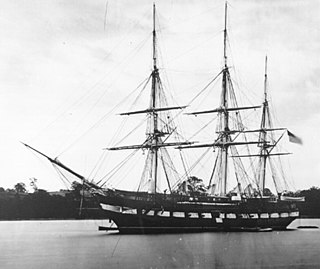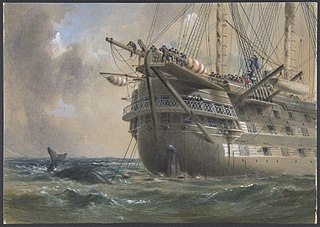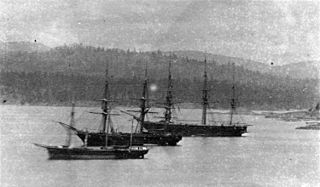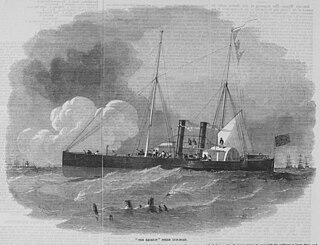Related Research Articles

A frigate is a type of warship. In different eras, the roles and capabilities of ships classified as frigates have varied somewhat.

A torpedo boat is a relatively small and fast naval ship designed to carry torpedoes into battle. The first designs were steam-powered craft dedicated to ramming enemy ships with explosive spar torpedoes. Later evolutions launched variants of self-propelled Whitehead torpedoes.

A ship of the line was a type of naval warship constructed during the Age of Sail from the 17th century to the mid-19th century. The ship of the line was designed for the naval tactic known as the line of battle, which depended on the two columns of opposing warships maneuvering to volley fire with the cannons along their broadsides. In conflicts where opposing ships were both able to fire from their broadsides, the opponent with more cannons firing – and therefore more firepower – typically had an advantage. Since these engagements were almost invariably won by the heaviest ships carrying more of the most powerful guns, the natural progression was to build sailing vessels that were the largest and most powerful of their time.

An ironclad is a steam-propelled warship protected by iron or steel armor plates, constructed from 1859 to the early 1890s. The ironclad was developed as a result of the vulnerability of wooden warships to explosive or incendiary shells. The first ironclad battleship, Gloire, was launched by the French Navy in November 1859 – narrowly pre-empting the British Royal Navy.

A warship or combatant ship is a naval ship that is built and primarily intended for naval warfare. Usually they belong to the armed forces of a state. As well as being armed, warships are designed to withstand damage and are typically faster and more maneuverable than merchant ships. Unlike a merchant ship, which carries cargo, a warship typically carries only weapons, ammunition and supplies for its crew. Warships usually belong to a navy, though they have also been operated by individuals, cooperatives and corporations.

A gunboat is a naval watercraft designed for the express purpose of carrying one or more guns to bombard coastal targets, as opposed to those military craft designed for naval warfare, or for ferrying troops or supplies.

In the 18th century and most of the 19th, a sloop-of-war in the Royal Navy was a warship with a single gun deck that carried up to eighteen guns. The rating system covered all vessels with 20 guns and above; thus, the term sloop-of-war encompassed all the unrated combat vessels, including the very small gun-brigs and cutters. In technical terms, even the more specialised bomb vessels and fireships were classed as sloops-of-war, and in practice these were employed in the sloop role when not carrying out their specialised functions.

HMSGannet is a Royal Navy Doterel-class screw sloop-of-war launched on 31 August 1878. It became a training ship in the Thames in 1903, and was then loaned as a training ship for boys in the Hamble from 1913. It was restored in 1987 and is now part of the UK's National Historic Fleet.

HMS Agamemnon was a Royal Navy 91-gun battleship ordered by the Admiralty in 1849, in response to the perceived threat from France by their possession of ships of the Napoléon class.

A floating battery is a kind of armed watercraft, often improvised or experimental, which carries heavy armament but has few other qualities as a warship.

HMS Miranda was a 14-gun wooden screw sloop of the Royal Navy. As part of the 1847 Program, she was designed by John Fincham, Master Shipwright of Portsmouth and is considered an improved Rattler with the design approved on 3 November 1847. She was ordered on the 25th of April 1847 with the name Grinder from Royal Dockyard, Sheerness. On the 3rd of November 1847 she was reordered as the Miranda from Sheerness Dockyard. Launched in 1851, she was completed to see action in the Russian War of 1854 - 55. In 1854 she was in the White Sea and participated in the bombardment of the Port of Kola. She then participated in the Sea of Azov during 1855. Two of her crew were awarded the Victoria Cross for their bravery. Towards the end of her career she transported troops during the New Zealand war. She was reclassified as a corvette by 1862, She was sold for breaking in December 1869.

HMS Sans Pareil was a 70-gun screw propelled ship of the line of the Royal Navy.

HMS Malacca was a 17-gun wooden sloop of the Royal Navy. She was ordered on 9 November 1847 from Moulmein, Burma to be built of teak. As a Surveyor's Department design, Malacca was based on the Conflict designed sloop which was approved on 9 December 1848. After launching in April 1853 she was commissioned the following month to be sailed to England for the fitting of her engine. She entered British Naval service in 1854 and served three commissions including action in the Russian War 1854 - 55 before being sold in 1869. Her resale to Japan, she served in the Japanese Navy as a training ship until broken in 1906.

Feyzâ-i Bahrî was one of four wooden-hulled Mecidiye-class paddle frigates built for the Ottoman Navy in the 1840s; they were the first Ottoman-built warships powered by steam. She served with the fleet until 1867, including during the Crimean War, where she saw a minor battle with a Russian frigate in the Black Sea. Feyzâ-i Bahrî ferried soldiers to Crete during the Cretan Revolt in 1866 and was converted into a dedicated transport vessel the following year. She served in that capacity until 1878 when she was decommissioned, being broken up in 1880.

SMS Nix was the lead ship of the two-vessel Nix class of avisos built for the Prussian Navy in the early 1850s. After commissioning in 1851, Nix saw little activity, apart from short training exercises and cruises in the Baltic Sea, which were frequently punctuated with boiler fires. A dissatisfied Prussian Navy decided to sell both Nix-class ships. In 1855, the Prussians sold Nix to the British Royal Navy in exchange for the sail frigate Thetis, and was commissioned as HMS Weser. She saw action during the Crimean War at the Battle of Kinburn in October 1855, and thereafter saw little activity, being based in Malta. She was ultimately decommissioned in 1865, used as a harbor ship, and then sold to ship breakers in 1873.

SMS Salamander was the second and final member of the Nix class of avisos that were built for the Prussian Navy in the early 1850s. The ship saw little active use, apart from limited training exercises. In 1855, the ship was sold to the British Royal Navy in part exchange for the sail frigate Thetis and was commissioned as HMS Recruit. After entering service, she saw action in the Black Sea during the Crimean War, where she took part in operations against Russian logistics. The Royal Navy thereafter did not put the vessel to much use either, as she remained idle in Valletta, Malta, until late 1861, with the only events of note taking place in 1857 when she helped recover a gunboat and two merchant ships that had run aground in the region. Recruit was recalled to Britain in late 1861, thereafter remaining in reserve until 1869. In the 1870s she became a merchant ship, and was then used as a gunpowder magazine at Cape Town.

The Nix class was a pair of avisos built for the Prussian Navy in the early 1850s. The class comprised two ships: SMS Nix and Salamander. They were ordered as part of a modest program to strengthen the fleet at the urging of Prince Adalbert of Prussia in the immediate aftermath of the First Schleswig War, which had demonstrated that the weak fleet could not challenge the ability of Denmark to impose a blockade of Prussian and German ports. They were small vessels with a shallow draft, since they were intended to operate close to shore to defend Prussia's coast. Neither vessel saw significant service in the Prussian Navy before being sold to the British Royal Navy in exchange for the frigate Thetis in 1855. They were renamed Weser and Recruit, respectively, and the former saw action during the Crimean War in the Black Sea later in 1855. The two ships saw little activity after their sale to Britain, with Recruit being laid up in 1861 and Weser following in 1865. Recruit was sold for merchant service in 1870, while Weser was discarded in 1873.
HMS Surly was a mortar vessel of the Royal Navy built at Blackwall Yard in 1855. Later that year she served with Anglo-French forces at the Bombardment of Sweaborg, Finland, during the Crimean War. Her mortar, and those of the other vessels deployed, required several repairs but the bombardment had a greater effect than had been anticipated. Despite this mortar vessels fell out of use in the Royal Navy due to the development of rifled artillery. After being renamed MV9 later in 1855 she was broken up in November 1863.
References
- Winfield, Rif; Lyon, David (2004). The Sail and Steam Navy List: All the Ships of the Royal Navy 1815–1889. London: Chatham Publishing. ISBN 978-1-86176-032-6.